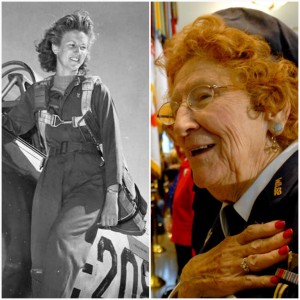
Strohfus, known as Betty (or sometimes Liz) Wall when she joined the WASPs — Women’s Air Force Service Pilots — died March 6, [2016] in Faribault, Minn., after a lifetime devoted to ensuring a legacy for the women once entrusted with the military’s newest planes. She was 96.
Strohfus spent years crisscrossing the country in her blue uniform to champion the WASPs, whose contributions to the war effort were never fully acknowledged.
“She had to fight most of her life for recognition,” said her son, Art Roberts of Northfield, Minn. “The ladies, for the most part, were unaware they were pioneers. They wanted to fly planes and help their country.”
“She had to fight most of her life for recognition,” said her son, Art Roberts of Northfield, Minn. “The ladies, for the most part, were unaware they were pioneers. They wanted to fly planes and help their country.”
When Strohfus learned in the 1970s that the law didn’t recognize WASPs as veterans, she and others lobbied Congress for a change and won. Last week, U.S. Sen. Amy Klobuchar and several congressional allies called on the Army to allow burials for WASPs at Arlington National Cemetery. Klobuchar met with Strohfus in January to discuss the policy with her.
“While Betty wanted to be buried with her family, she stood up for fellow WASP sisters and fought for them to have the same rights as other veterans,” Klobuchar said.
Strohfus, then 22, had dreamed of flying when she was a child. She borrowed money to join the Faribault flying club, putting up her bike as collateral, but then saw an ad for the WASPs and quickly logged the required 35 hours in the air.
She applied along with about 25,000 other women. Of that number, only 1,047 made the cut — including Strohfus, who trained to fly every aircraft and simulate enemy fights in mock air combat with U.S. bombers. Elizabeth Wald Strohfus trained to fly every aircraft. “The planes … never asked if you were a man or a woman.”
“They were beautiful, they were smart, they were dedicated women and they gave it their all,” said Cheryl Young of Minneapolis, who worked with Strohfus in the 1990s on a book about her three years in the WASPs.
During 1943 and 1944, Strohfus was sent to a U.S. Army air gunnery school in Las Vegas to help train men for in-flight combat. Her job was to dive an AT-6 Avenger fighter-trainer onto formations of B-17 bombers to give the gunners target practice, using special cameras in place of guns.
She towed cloth sleeves behind her plane so the bombers’ gunners could practice with live ammunition. A couple of fellow WASPs died that way, among the 38 WASPs who died during the war in crashes and other accidents.
Strohfus also trained men to fly by instrument. A few of them didn’t think a woman could handle a plane.
“It was just something you had to put up with,” she told the Star Tribune in 1991. “But what I loved was that the planes I flew never asked if you were a man or a woman; they flew just as well for me as anyone else.”
Roberts said that after his retirement he traveled with his mother to public appearances. “Her message was always positive, that people need to follow their dreams,” he said.
We honor you, Elizabeth Strohfus.
